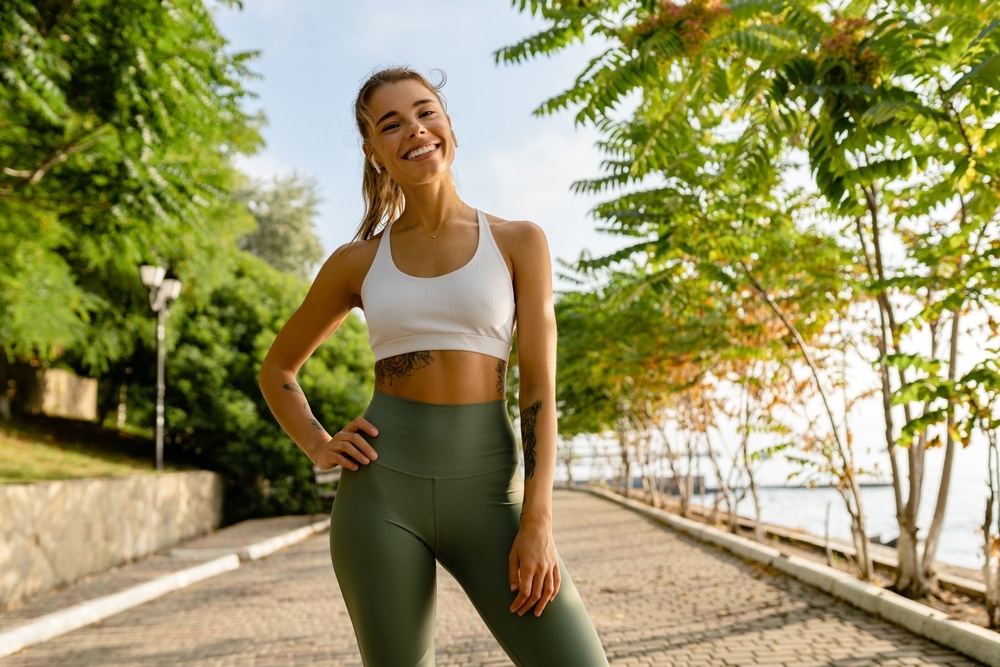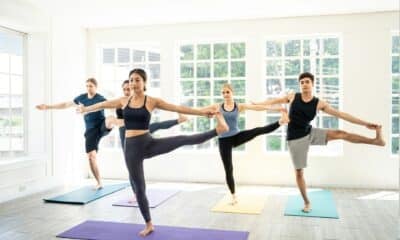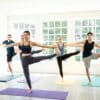Best 15-Step Park Workout Guide
Surrounded by the lush scenery and the sounds of nature, a park offers you a delightful atmosphere that can lift your spirits. What’s more, these settings are perfect for an engaging workout that can activate every muscle in your body. If you’re a parent enjoying some playtime with children, or an urbanite seeking an escape amidst trees and grass, we have crafted a comprehensive outdoor exercise routine just for you.
It’s common knowledge that exercising routinely is crucial for good health. However, you may not be aware of the extra perks you receive when you take your fitness routine outdoors. Parks, which are typically abundant in green spaces, contribute significantly to a community’s wellbeing in several ways as outlined by the National Recreation and Park Association:
- Environmental Conservation: Parks are sanctuaries for wildlife, contribute to better water quality, and help in reducing air contamination.
- Social Equity: Parks offer an inclusive, cost-effective recreational space that nurtures a robust and healthy society.
- Health and Wellness Benefits: Parks offer spaces for physical activity for all age groups, promoting good health, clean air, and connection with nature.
Regular workouts amidst nature not only boost your physical condition but also elevate your mental state. Below, you’ll discover scientific data that supports outdoor exercises and a specialized 15-step workout recommended by a fitness expert, designed to utilize the natural features of a park.
The Advantages of Exercising at the Park
Your workout location can greatly impact your experience, with parks offering an exceptional environment that can enhance your overall well-being. Combining the benefits of physical activity with those provided by being outdoors can result in numerous health gains.
“Taking your exercise regimen out into the fresh air is transformative for both your physical and emotional state,” comments Sasha Hanway, lead coach for Ladder’s Yoga x Strength program. “It provides variety for your muscles, helps prevent fitness plateaus, and brings you closer to nature — a change from the artificial lights of indoor gyms — while also introducing you to fresh air and helping your body maintain its natural rhythms.”
Research further affirm the benefits of outdoor exercises. Getting active in a park promotes health in the following ways:
Enhanced Mental Well-Being
Not only is the happiness at parks infectious, but being surrounded by nature can amplify your state of mind as well.
“Immersing yourself in green surroundings can significantly decrease stress levels and facilitate mental recovery,” states Jun Wu, PhD, an expert in environmental and occupational health from UC Irvine. “Engaging in activities at the park, from walking to simply relaxing under a tree, can alleviate stress and combat negative thinking.”
Spending 20 to 90 minutes in nature-related activities has been shown to improve mental health and may even give you an extra boost of motivation.
“Greenery encourages physical activity which not only keeps you fit and enhances heart health, but also perks up your mood, lowers the chances of depression and anxiety, and reduces risks associated with mental health conditions,” Wu explains.
Improved Sleep Quality
Difficulties with sleep, such as waking up at 3:30 A.M. due to hormonal changes, for example, can be mitigated by exercising in the park.
While exercise in general is beneficial for sleep, outdoor activities have been linked to increased sleep duration. Wu notes that your sleep quality is likely to be better as well: “Outdoor exercise such as running, walking, or yoga can contribute to more restful sleep during the night.”
Heightened Focus
If you find yourself frequently distracted during important tasks, exercising outside could be a game-changer.
A study contrasting 15-minute indoor versus outdoor walks revealed that time spent exercising outdoors resulted in enhanced attention and working memory. Engaging in outdoor physical activity might be particularly useful prior to events where your full concentration is required.
Robust Physical Health
A workout in the park can benefit your body in many respects. Research indicates that exposure to natural environments can lower cortisol levels – a stress hormone that, when not managed, can lead to numerous health issues.
In addition, being in green spaces can have positive effects on heart health, blood pressure, and indicators of inflammation.
Access to Cleaner Air (Generally)
And of course, there’s the clean air. Parks often have an abundance of trees and plants that can enhance the quality of air. “These green areas trap pollutants like ozone at ground level, sulfur dioxide, nitrogen oxides, and particulate matter. Trees are particularly effective at filtering these pollutants,” states Wu. (However, this might not be applicable if local air quality is poor — always check your local air quality index (AQI) before engaging in outdoor exercise.)
The Optimal Park Exercise Routine
Once you’re at the park and ready to start, you may wonder which form of exercise is most suitable. Should your focus be on cardiovascular health or is it best to utilize the environment for a resistance training session?
“The possibilities are endless, especially when there’s a staircase or a bench,” says Hanway. “My preference is a combination of strength, Pilates, and yoga. Some might feel hesitant about working out publicly, but I like to think that by doing so, you might inspire others to engage their bodies as well.”
Parks may also be equipped with exercise fixtures, such as high bars, incline benches, and gymnastic rings, which support a variety of bodyweight exercises. Plus, there’s always the option of taking a stroll on the paths or actively playing with children. If, however, you desire a thorough workout covering all major muscle groups, try the following park-based workout suggested by Hanway.
Your Comprehensive 15-Step Park Workout Plan
Before diving into the more intense part of your regimen, Hanway encourages starting your session gradually. “Begin with three deliberate breaths. Inhale deeply, lifting your arms above your head, filling up from your belly, through your ribs, to your chest. Hold your breath for a moment, and then exhale as you bring your hands towards your heart center, releasing air from the chest, through the ribs, and belly,” she instructs. “Repeat this three times to set the stage for your workout.”
Warmup
1. Skip
“A proper warmup is essential, so start with skips. It’s as simple as it sounds,” advises Hanway. “This exercise puts your leg strength, balance, and coordination to the test while signaling to your nervous system that it’s time to get moving!”
- Begin by stepping forward with one foot.
- Continue with a hop on the same leg.
- When landing, step forward with the opposite foot and perform a hop on that leg.
- Keep alternating legs for 30 seconds.
2. Walking Hamstring Scoop
Feeling stiff from sitting all day? Loosen up your hamstrings and get your heart pumping with this dynamic stretch.
- Stand straight, then step forward with your right leg, keeping it extended.
- Bend both arms, reaching towards the ground in a scooping motion, while hinging at the hips to stretch your right hamstring.
Rise back up, move forward with your left foot, and echo the movement.
- Continue your scooping motions for half a minute.
3. Side Step Squat with Hand Touch
According to Hanway, this exercise is great for warming up your buttocks, back of the thighs, and frontal thigh muscles. It also puts your balance and midsection to the test by having you move to either side and twist your body – a terrific way to engage muscles that are not always used regularly.
- Begin standing upright, then step out broadly to your right and bend your right knee, pushing your hips back and angling your torso slightly forward at about 45 degrees.
- Reach the floor near your right foot with your left hand, then return to standing in the center.
- Switch sides, doing this for half a minute.
Legs (for 2 to 3 rounds)
4. Bodyweight Squat
This movement will focus on the frontal thigh muscles, buttocks, back of the thighs, and calves. Hanway approves of performing squatting exercises with a band as it increases lower body strength and joint movement.
- Stand with feet about hip-distance apart, toes slightly turned out. If you have one, position a resistance band above your knees for added intensity.
- While keeping your knees aligned with the direction of your toes, sit downward as if going into a chair.
- Go down until your knees make about a right angle, then push down through your feet to rise.
- Do this for 15 cycles.
5. Hip Hinge Exercise
If you are targeting the back part of your body, Hanway recommends this hip-bending movement that works your buttocks, back of the thighs, as well as your core and lower back functionality.
- Stand with your feet apart in line with your hips.
- Bend forward at the hips, pushing your buttocks backward as if to shut a door with your rear end.
- Bend until your upper body is nearly parallel to the floor.
- Push through your heels and straighten up to your initial position.
- Perform 10 repetitions.
6. Right Leg Focus Step-Up Exercise
An excellent exercise for targeting the right-side buttocks, promoting single-leg balance, and midsection firmness, as outlined by Hanway.
- Place your right foot onto a stair or bench.
- Lean forward from the hip area moderately.
- Propel yourself up with your right heel and clench the right glute as you stand.
- Do 8 reps.
7. Left Leg Focus Step-Up Exercise
What’s performed on one side must be balanced out on the other—single-side training is key for muscular symmetry. Here we have the same motion, but for the left side.
- Position your left foot onto a step or bench.
- Lean forward at your hips a little.
- Propel up through your left heel, tightening your left buttock as you stand.
- Complete 8 repetitions.
Upper Body (for 2 to 3 sets)
8. Incline Press-Up
Hanway is a fan of press-ups for engaging the chest, arms, shoulders, and core muscles – she dubs the press-up as a supreme full-body exercise. Elevate your hands on something like a park bench or stair step if you find a standard press-up too challenging.
- Position your hands on a step or bench, ensuring they are directly beneath your shoulders.
- Maintain a straight line from your head to your feet and pull your belly in towards your spine.
- Lower yourself down, aiming your elbows at a 45-degree angle. Descend as far as your form allows without sagging your hips.
- Push back up and complete 10 cycles.
9. Deltoid Taps
Hanway says that “Deltoid Taps not only enhance midsection balance but also build shoulder muscle.” Position your hands higher off the ground to make the exercise slightly less difficult. “Expert tip: Spread your feet out wider to maintain equilibrium,” she suggests.
- Start on hands and knees with hands directly below shoulders and knees under hips.
- Stretch your legs back so that your body forms a straight line.
- Stiffen your core and bring the opposite hand to your opposite shoulder.
- Continue alternating, aiming for 10 reps total.
10. Superhuman to Press-Up
Switch over to a soft spot on the grass or use a mat for these exercises. You’ll engage your entire body with this combination, but Hanway especially likes the way superhuman moves to press-ups engage your back and tighten the core.
- Face down, stretch your arms ahead. Activate your glutes, back of the thighs, and backbone.
- Lift your legs and arms off the floor together.
- Look straight down to keep your neck in line.
- Do this four times, then reposition your hands beneath your shoulders and either on your knees or toes and execute one complete press-up. That counts as 1 repetition. Repeat this four times, aiming for a total of five reps.
Core Muscles (for 2 to 3 rounds)
11. Dead Bug Movement
Don’t let the name scare you; this is a top-notch core exercise. “Dead Bugs bolster the midsection, enhance coordination, and work on the abdominals, hip muscles, and lower back,” notes Hanway.
- Lie down, your arms reaching skyward and knees bent at a right angle.
- Lower your right arm and the opposite leg toward the floor while you press your lower back into the ground.
- Swap sides after returning to the initial pose.
- Shoot for 20 repetitions.
12. Bear-Pose to Plank
Boost your posture and lower injury risk by reinforcing your core. “The Bear-Pose to Plank exercise zeroes in on your core and shoulders and engages the deep core muscles for stability,” Hanway explains.
- From a plank position, step forward with each foot to achieve a bear-like stance (imagine a floating tabletop, knees below hips).
- Engaging your core tightly (as if balancing a drink on your back), reverse into the plank position.
- Go through 10 repetitions.
Winding Down
13. Puppy Stretch Pose
Time to give your body the relaxation it deserves after the workout! This pose provides an intense stretch for your back and shoulders.
- Get on all fours into the tabletop position.
- Keep your hips aligned above your knees.
- Stretch your arms forward, letting your forehead rest on the ground.
- Stay here and breathe deeply for 5 to 10 breaths, allowing your chest to get nearer to the ground.
14. Relaxed Squat Pose
Hip fluidity is crucial for your range of motion and upright posture. “Relaxed squats help with hip opening and test your joint mobility,” Hanway mentions.
- Stand with your feet somewhat broader than hip-width apart.
- Angle your heels in and toes out about 45 degrees, then lower your hips towards the floor.
- Pull in your tailbone and draw your hands to your heart’s center, pressing your palms together.
- Breathe in this position for 5 to 10 breaths, trying to keep your heels on the floor. If you can’t keep your heels down, try using a yoga block to sit on.
15. Dynamic Standing Bend
If your back often feels the weight of your tension, “a standing bend can help to release stiffness throughout your back and the rest of your body,” says Hanway.
- Take a stand with your feet aligned with your hips.
- Keep a good bend in your knees and gently bring your chin towards your chest, then fold forward over your thighs.
- Hold onto your elbows with the opposite hands and sway gently.
- Stay for 5 to 10 breaths, attempting to lean further to the floor with each exhalation.
















